Over the years, the Texas residential property affidavit (also known under its short names Form T-47 and T-47 Affidavit) has caused certain confusion amongst Texas residents. We are about to clear the air for you a little. Naturally, when a real property unit is sold, a proper title survey must be performed so that the future owner does not have any problems. Parties to the sales transaction should come to terms as to what survey to use for the ownership transfer and whether they need a new survey to be held. As the seller is more interested in resolving the matter, that person is responsible for providing a residential property affidavit.
Although the document is merely straightforward, there are some peculiarities one needs to take into account when filling out this form. Below, you will find some more information on the T-47 Affidavit completion procedure, legal norms applied, and filing requirements.
What Is a Texas Residential Property Affidavit?
As mentioned above, this type of residential real property affidavit follows and authorizes an estate transactions survey. The buyer and seller may either agree to pay to get a new survey composed or use an already existing one for the transaction to come into force. If the parties eventually decide not to spend money on a new survey, they should use this affidavit form to complement and authorize an older survey.
Thus, the seller should use the T-47 form to attest the accuracy of a performed survey from their point of view. Therefore, as a seller, you will need to know precisely when to prepare the form and how to fill out the affidavit form correctly.
The Primary Purpose of the T-47 Affidavit
In plain words, the state title insurance companies use this document to assess and then claim the amount of coverage they are ready to provide for the subject piece of real property. Thus, the purpose of the Texas residential property affidavit seems pretty clear, but that is until you are faced with Paragraph 4 of the document. In this paragraph, the seller must indicate the date since when the real property unit has suffered no major changes. We will break it down in more detail to you what date to insert in the form compilation guidelines section below.
To sum up, the primary purpose of the T-47 affidavit form is to affirm there is no problem with the property’s title and all the necessary papers are in order. It is worth mentioning that should the seller put any date other than indicated in the last survey in an already notarized residential real estate affidavit, they will be facing some legal circumstances. If they do so by accident, they shall immediately inform the title company and request a new title survey.
How to Fill out the Texas Residential Property Affidavit Form?
First off, you should obtain the proper T-47 form template. You can either download it from the official state government’s website or go to the Texas Department of Insurance and receive it in person. However, there is another far more convenient option: you can use our latest software tools and developments to build and customize your form online. Working with online legal forms is particularly suitable because you can edit any mistake you make right away, and precision is of special importance when dealing with affidavits.
You can use the illustrated manual below to fill out the Texas residential property affidavit quickly and effortlessly.
Put the date and File Number
Insert the current calendar date in the top left corner of the form. Make sure it is the very same date when the document is composed and notarized.

On the opposite side of the line, one must enter the general file number. Leave the space for the title company to fill out to avoid any mistakes and misunderstandings.

Identify the Affiant(s)
The next two lines are designed to indicate the affiant’s personal information. Enter your full legal name (or multiple names in case there are several affiants) in the first blank line.
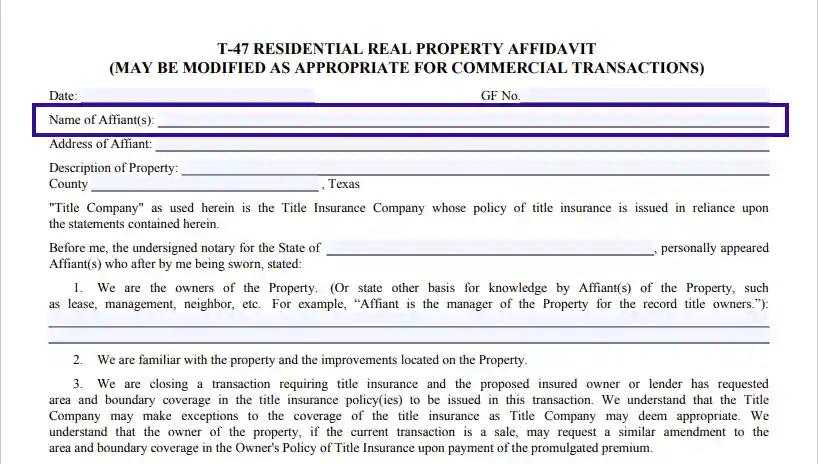
Provide the Affiant’s Physical Address
Then, proceed to fill out your physical address in the second line. Again, if there are several affiants involved in the transaction, ensure that you indicate all of their physical addresses respectively (one after another).

Describe the Property and Its Location
The seller should enter the legal description of the subject real property in the following lines. Technically, the description the seller decides to fill out should match the one indicated in the survey the seller is providing. If you do not have access to the previous survey for some reason, you can look the property’s legal description up in your tax records.
The second option you have in identifying the legal description (if neither of the previous ones works for you) is asking your realtor for help. Ensure to include every single detail up to the subdivision, if applicable.

Identify the Notary Public
You need to confirm that all sections of the affidavit are completed in the presence of a notary public. Therefore, indicate the notary’s full legal name in the following line.
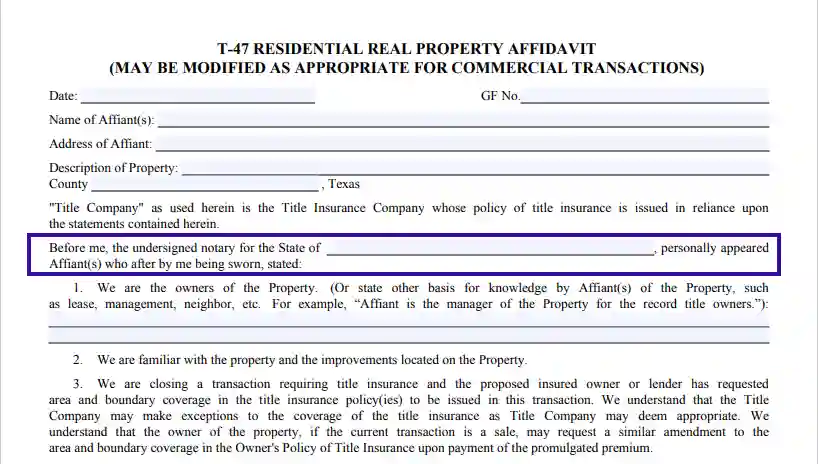
State Your Ownership Rights Type
Record the ownership rights that you have over the subject property. Besides the ownership itself, it can also be a lease, property management, or even neighborhood. Choose the option most appropriate for your particular case. An agent can fill out the form on your behalf, provided they have a relevant power of attorney.
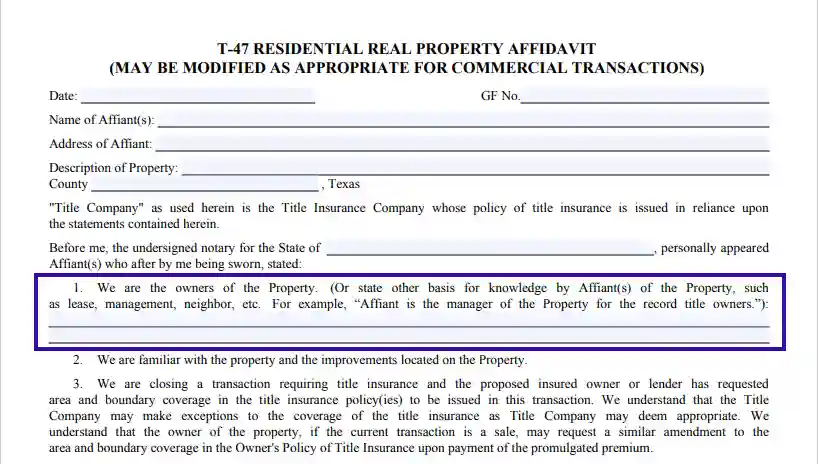
Put the Date of the Last Major Changes
As we have briefly mentioned above, this would be the trickiest part of the document. There is only one thing you need to determine in Paragraph 4, and it is the most recent date when any major changes to the subject real property have been made. You should enter the date indicated in the previous title survey (regardless of whether it was performed by you or the previous owner). The seller can also indicate the date when they purchased the house or any other tangible property.
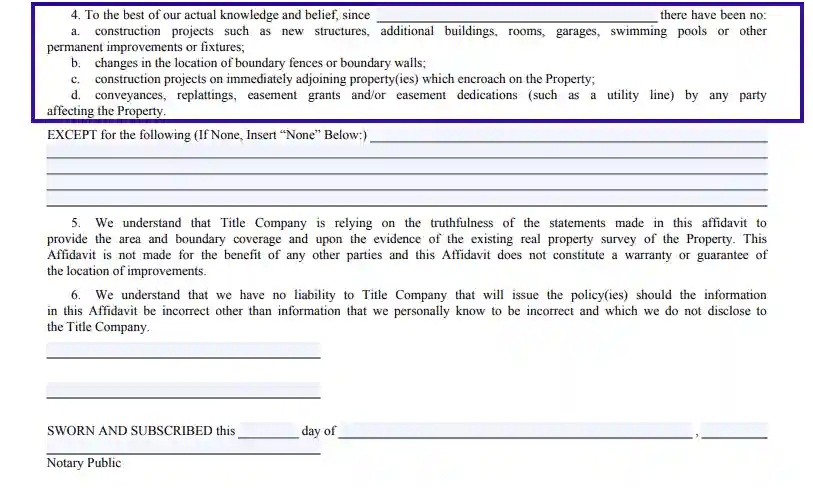
Provide Details (If Any)
Once you indicate the date, you need to define the changes that were made. If there were no major changes in the residential real estate since the designated date, put “None” in the section below. Thus, the seller confirms that there are no significant flaws or territorial changes of the property to their knowledge at the moment of transaction and ownership transition.
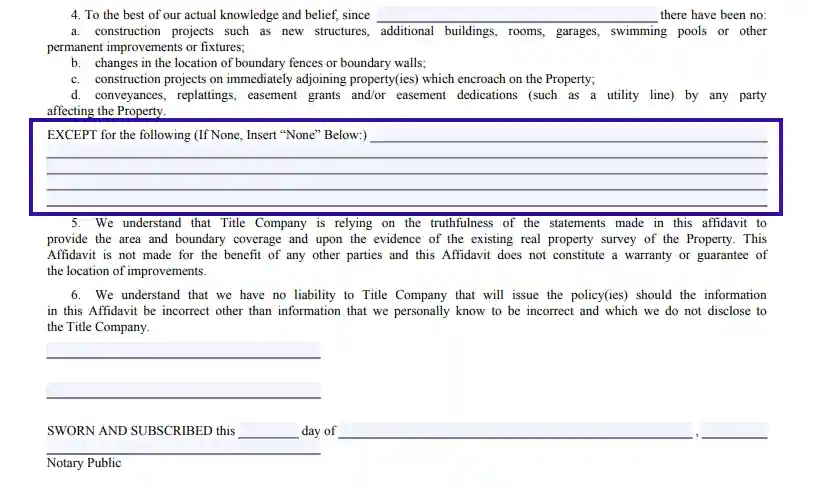
Notarize the Document
The document requires notarization. Therefore, you need to invite a notary public to the signing. You may also find yourself a notary in a bank, attorney’s office, a state governmental office, or title insurance companies. All of them would be equally suitable to notarize your completed T-47 affidavit form.
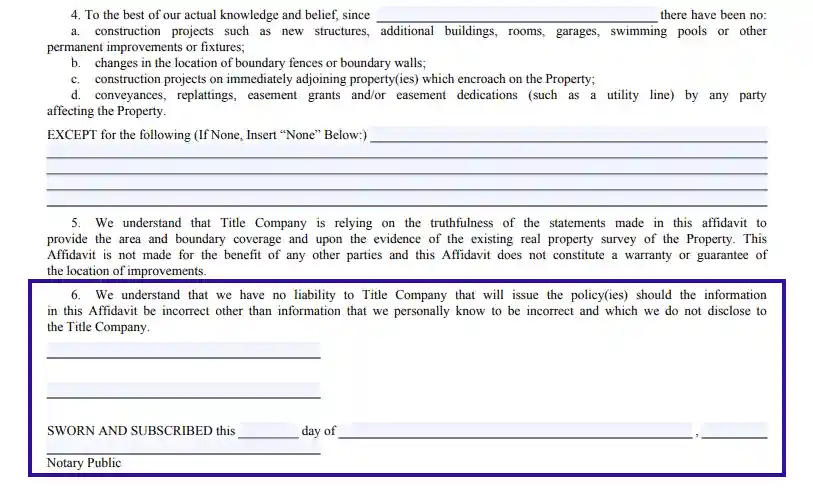
Why Use the T-47 Affidavit Form in Texas?
There are plenty of legal reasons for a property seller in Texas to use the residential real estate affidavit form. For example, you can assure the buyer that all the paperwork is transparent and in order. That, in turn, can persuade them to make their decision to purchase a piece of property in your favor. But let us not forget about another important reason to fill out the form, which is saving.
As a rule, people buying residential real property across the US require title insurance. The latter is a mutual legal commitment that one sells and another buys the exact property as described in the papers. It is crucial for the buyer to know that they are buying what they think they are buying. Otherwise, they might become part of fraudulent actions.
To prove the accuracy of either statement, the seller needs to perform a title survey or perform its existence. A title survey, in turn, may cost between $350 and $550 in Texas. This fact effectively means that the seller may save up to $500 by simply using a Texas residential real estate affidavit form. It is also worth mentioning that not only the seller might be held responsible for providing a new title survey. It really depends on how the parties negotiate and what conclusions they come to. Thus, the buyer and the seller may agree to share their duties as property owners and share the new title survey expenses.
